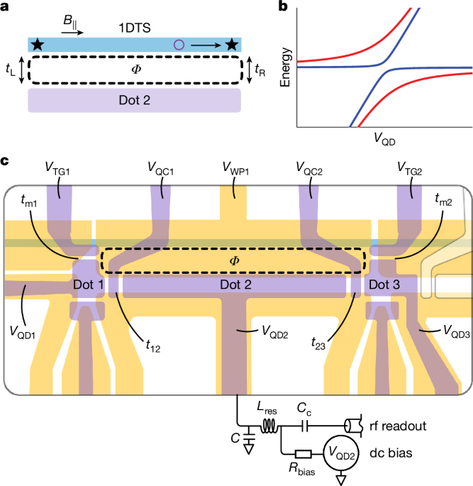I'll be keynoting at Qubit Conference® in Prague on May 27th, and I haven't been to this lovely city since 1983(!). Can't wait to get back.
Check out their agenda here: https://qubitconference.com/qubit-conference-prague-2025/
I'll be keynoting at Qubit Conference® in Prague on May 27th, and I haven't been to this lovely city since 1983(!). Can't wait to get back.
Check out their agenda here: https://qubitconference.com/qubit-conference-prague-2025/
If they couldn't even be bothered to look up how to pronounce Majorana correctly (MI-yor-ahna)... it's probably a good bet that the rest of the video's not very well researched either.
#majorana #topological #qubit #Quantum #QuantumComputing #Microsoft
@verge Microsoft Majorana 1 Qubit chip
“Microsoft has outlined its research in a peer-reviewed paper published today in Nature [link below], explaining how its researchers were able to create the topological qubit. Microsoft has helped create a new material made from indium arsenide and aluminum, and it has placed eight topological qubits on a chip that it hopes can eventually scale to 1 million.”

SciTech Chronicles. . . . . . . . . . . . . . . . . . . . . . . . . . . . . .Jan 17, 2025
#Xeon #anesthetic #neuroprotectant #TBI #Alzheimer's #Mouse #Clinical-trials Firefly #iSpace #CLPS #Blue-Ghost #Resilience #Birth-rate #pets #obligations #competition #pressures #affordable #mortgage #Mayors #2008 #homebuilders #qubit @quantum #antimony #Schrödinger #errorcorrection
Creating a Mechanical Qubit that Lasts Longer Than Other Qubits - Among the current challenges with creating quantum computers is that the timespan ... - https://hackaday.com/2024/12/27/creating-a-mechanical-qubit-that-lasts-longer-than-other-qubits/ #quantumcomputer #science #qubit
A quantum measurement you can do at home
https://www.youtube.com/watch?v=aJ1wB9Gwyrc
#physics #qubit #qubits #quantum #wavefunction #quantumentanglement #quantumphysics #schrodingerscat #HeisenbergUncertaintyPrinciple
_______
• Quantum mechanics course: https://www.youtube.com/watch?v=vBGSjcEvxUg&list=PLg-OiIIbfPj1t7zYsf6aj7wrGb9fghFDk&index=1
IBM releases 1,000+ qubit processor, roadmap to error correction - Enlarge / The family portrait of IBM's quantum processors, with the two... - https://arstechnica.com/?p=1988221 #quantumcomputing #quantummechanics #computerscience #errorcorrection #transmon #science #qubit #ibm
Intel to Ship Quantum Chip - In a world of 32-bit and 64-bit processors, it might surprise you to learn that In... - https://hackaday.com/2023/06/17/intel-to-ship-quantum-chip/ #quantumcomputing #computerhacks #qubit #news
How can we #combat #data #theft, which is a real issue for society? #Quantum #physics has the solution. Its theories make it possible to encode information (a #qubit) in single particles of light (a #photon) and to circulate them in an #optical fiber in a highly secure way.
#QuantumScience #sflorg
https://www.sflorg.com/2023/03/qs03132301.html
#Scientists are vigorously competing to transform the counterintuitive discoveries about the #quantum realm from a century past into technologies of the future. The building block in these technologies is the quantum bit, or #qubit.
#QuantumScience #Physics #sflorg
https://www.sflorg.com/2023/03/qs03062301.html
UNSW Sydney research demonstrates a new type of #quantum bit in silicon, called ‘flip-flop’ #qubit, which can facilitate the construction of a large-scale quantum #computer.
#QuantumScience #Physics #sflorg
https://www.sflorg.com/2023/02/qs02132301.html
What’s next for #QuantumComputing
Companies are moving away from setting #qubit records in favor of practical hardware
#IBM will debut its Heron processor, which will have just 133 qubits but each chip is able to connect directly to other Heron processors
https://bit.ly/3IqsWy4
#Silicides form when #elemental #niobium is deposited onto #silicon during the fabrication process of a #transmon #qubit. They need to be well understood to make devices that reliably and efficiently store #quantum information for as long as possible.
#QuantumScience #Physics #sflorg
https://www.sflorg.com/2023/01/qs01232301.html
#Quantum #computers can process large amounts of #data faster because they perform many #calculation steps in parallel. The information carrier of the quantum computer is the #qubit. With qubits there is not only the information "0" and "1", but also values in between.
#QuantumScience #Technology #sflorg
https://www.sflorg.com/2022/12/qs12202201.html
#Introduction:
My PhD was about molecular magnetism, and I have since specialized in single ion magnets and molecular spin qubits (and now: pbits!). More  than
than  . Mostly a researcher, recently also teaching part-time.
. Mostly a researcher, recently also teaching part-time.
@agaitaarino@todon.nl : my  activism (in Spanish).
activism (in Spanish).
tag cloud: #molecule #magnetism #spin #qubit #nanoscience #chemistry #physics